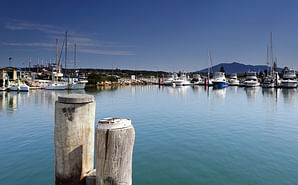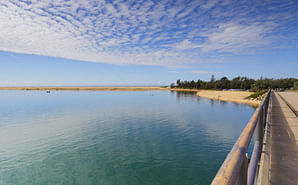Coolagolite Bushfire recovery support
Face-to-face bushfire recovery support is available for individuals, families, farmers and businesses in the Bega Valley Shire Council.
The NSW Reconstruction Authority is providing support to individuals, families, farmers and business owners affected by the Coolagolite Road bushfire. This update provides information on the different clean-up, waste removal and support services available for the community.
Face-to-face support
A Recovery Centre was opened between Wednesday 11 – Friday 14 October 2023 in Bermagui. As community need changes, the Service NSW website will be updated with information on where you can seek face-to-face support: www.service.nsw.gov.au/services/recovery-centres.
Recovery Assistance continues to be available at Anglicare, Shop 1 & 2, 50 Princes Highway, Cobargo. The NSW Reconstruction Authority will be available to connect you with services and support.
Returning to your property safely
Road access, assessments and repairs
Bega Valley Shire Council is progressively undertaking road assessments across the affected area. Once declared safe to re-open, Council will update Live Traffic NSW.
Visit www.livetraffic.com to keep up to date on road access and any repair works.
Water contamination
Rainwater may be contaminated by debris, dead birds or animals, fire retardants, or large amounts of ash. The water may also be contaminated if the tank, internal lining or plumbing was damaged.
The presence of ash and debris in rainwater is unlikely to be a health risk, but could affect the appearance and taste. Fire retardants currently used in Australia are of low toxicity, but may also affect the appearance and taste of rainwater.
If you are concerned that your rainwater tastes, looks or smells unusual, or you suspect your rainwater has been contaminated, an alternative safe water supply should be used for human or animal consumption.
If you need to bring in water, it is important you use an accredited water carter. If the water was used for firefighting by the NSW Rural Fire Service, reimbursement can be sought from Service NSW at 13 77 88.
Further information is available at www.health.nsw.gov.au/environment/water/Pages/rainwater-bushfires.aspx.
Damage to wastewater systems
On-site wastewater systems, such as septic tanks and aerated wastewater treatment systems (AWTS), and their land application systems, for example sprinklers and below ground drippers, can be easily damaged during a bushfire.
Avoid driving or walking near a fire-affected system until it is assessed by a licensed plumber or service technician familiar with on-site wastewater systems.
Bega Valley Shire Council is intending to assess wastewater systems on affected properties. Further advice will be provided on scheduling inspections soon.
More information on managing wastewater can be accessed at www.health.nsw.gov.au/environment/factsheets/Pages/bushfires-onsite-wastewater-systems.aspx.
Clean-up of waste and debris
Trees and vegetation on private property
Small amounts of felled trees and burnt vegetation can be disposed of at your local waste facility.
You will need to pay for waste disposal and any associated clean-up costs. Contact Service NSW on 13 77 88 if you need help with waste clean-up and disposal as eligibility criteria applies.
Treated timber
Copper chrome arsenate (CCA) is a wood preservative used to protect wood from rotting, fungi and insects. Burnt CCA-treated timber will contain arsenic. The NSW EPA provides information on safe disposal of CCA-treated timber and ash and steps you can take to protect your health.
Freshly treated CCA-timber can be identified by its yellow/greenish colour which fades to grey over time. It is not always easy to identify if a product is CCA-treated timber and if in doubt it is important to treat the timber as if it does contain CCA.
Small amounts of CCA-treated timber ash can be placed in a sealed plastic bag and disposed of at your local waste facility. Larger amounts of CCA-timber ash can be disposed of at Bega Valley Shire Council’s Central Waste Facility (CWF) at Wolumla. Ash must be double bagged and sealed to ensure it’s contained during transport and handling. Do not put CCA-timber or ash in your garden organics bin.
You will need to pay for waste disposal and any associated clean-up costs.
Visit www.epa.nsw.gov.au/reporting-and-incidents/bushfire-recovery and scroll down to Burnt treated timber and ash for more guidance.
Hazardous materials and asbestos
Buildings and other structures damaged in a bushfire leave health and safety hazards in the remaining debris and ash. If a fire-damaged building was built before 1990, it is likely to contain asbestos.
A fire damaged asbestos building does not generate significant levels of asbestos fibres in the air unless it is disturbed. Although it is generally low risk to walk around or nearby asbestos damaged buildings, risks can increase when the material is disturbed.
The site will need to be continually damped down so as not to cause dust or be sprayed with polyvinyl acetate (PVA), or a similar sealant, to reduce the risk of the asbestos fibres becoming airborne (further reapplication requirements need to be monitored). This needs to continue until the site is cleaned up. Dust suppression should not be so great that it causes runoff into nearby drains and waterways.
It is advisable you do not do any clean-up of asbestos yourself. Asbestos will be removed by a licensed asbestos removalist, who will ensure work is carried out safely.
All bushfire generated waste that contains asbestos must only be handled by appropriately trained people and disposed of at a landfill that can lawfully receive this type of waste. For the Bega Valley, this landfill is located at the Central Waste Facility (CWF) at Wolumla. Waste delivered to the CWF for disposal must be done so by a contractor, given the site is closed to the general public.
For more information on asbestos management, visit SafeWork atwww.safework.nsw.gov.au/resource-library/natural-disasters/property-hazards - following-a-bushfire-fact-sheet
Damaged buildings or structures
If you have damaged structures on your property and are insured, check with your provider about support for clean-up. At this stage, non-or under-insured properties will be required to self-manage structural clean-ups and disposals.
Clean-up and replacement of fencing
Bega Valley Shire Council is conducting impact assessments to determine the need for fencing clean-up, disposal and replacement.
Once this work is complete, information will be provided on support for fence replacement.
Fire-impacted fencing (free of dirt/vegetation) may be taken to the Bermagui waste transfer station for disposal.
Using private contractors
If you're using a building contractor or tradesperson for services to assess or rebuild structures on your property, you should check that they have a valid contractor licence.
You can check for a licence online. If you can't find it, contact NSW Fair Trading to confirm that the person does hold a contractor licence. By law, all contractors must show their licence number on all advertising, stationery and signage.
You can check a building licence at www.service.nsw.gov.au/transaction/check-a-builder-or- tradesperson-licence
Looking after yourself and others
Bushfire mental health support services
Bushfires often cause trauma and distress for individuals, families and communities. Many people affected will recover over time with support from relatives, friends and colleagues. Some people will require additional psychological support, especially considering the compounding events in the Bega Valley area.
There are a range of specific resources to help people work towards recovery in the event of a disaster. The Disaster Recovery Chaplaincy Network, NSW Health, the Australian Red Cross, Salvation Army and Rural Financial Counselling Service are available at the Recovery Centre to provide support where needed.
Support services can also be contacted by calling the NSW Mental Health Line on 1800 011 511 or Service NSW on 13 77 88.
Looking after yourself
During a bushfire emergency, and when returning home, it is important to take care of yourself and your mental health.
Remember to:
- spend time with family and friends
- try to get back to a routine but don’t push yourself and work too hard
- continue a healthy lifestyle (try to eat well, sleep and exercise)
- take time out, but don’t isolate yourself
- accept help when it’s offered.
It’s important you seek professional help if you are experiencing extreme feeling of distress, emotional reactions that last for more than a few weeks, or distress that interferes with your regular everyday activities.
More information is available at www.service.nsw.gov.au/services/health-and-care/mental- wellbeing-resources.
Grants and donations
Available grants
A disaster declaration has been made by the Australian and NSW Governments for the Bega Valley area, opening up access to a range of special assistance measures for the community.
Grants and loans are available for primary producers, small businesses, sporting and recreation clubs and not-for-profit organisations impacted by the bushfire. These include:
- Primary producers and small businesses:
- Concessional loans up to $130,000
- Transport subsidies up to $15,000
- Sporting and recreation clubs:
- Concessional loans up to $12,000
- Grants up to $2,000
- Not-for-profit organisations:
- Concessional loans up to $25,000
Contact Service NSW on 13 77 88 to find out more or to apply. You can also visit disasterassistance.service.nsw.gov.au to locate the assistance available in the Bega Valley area.
If you need donation support
Community members who have been impacted by the fires are able to access the following avenues of donation support:
Bega Valley Community Disaster Relief Fund
Led by Bega Valley Shire Council in partnership with the Social Justice Advocates of the Sapphire Coast (SJA).
How you can access or find more information:
Contact Bega Valley Shire Council
02 6499 2222
council@begavalley.nsw.gov.au
GIVIT Bushfire Appeal
Led by GIVIT.org.au, a national online Not-For-Profit organisation that matches generosity with genuine need.
Support available:
Impacted individuals can use GIVIT to request support via donated goods and services (i.e., vouchers beds, fridges, trade support etc)
How you can access or find more information:
- Speak to an Anglicare volunteer at Shop 1 & 2, 50 Princes Highway, Cobargo; or
- Visit www.givit.org.au/need-help to find a local registered organisation who can assist
If you want to make a donation
For anyone wanting to donate towards the impacted community, Bega Valley Shire Council has an existing donations appeal.
The Bega Valley Community Disaster Relief Fund (BVCDRF) is a perpetual disaster relief fund established by the Bega Valley Shire Council in partnership with the Social Justice Advocates of the Sapphire Coast (SJA).
You can donate to the Fund via bank deposit online or via your local bank branch. More information is available at begavalley.nsw.gov.au/community/bega-valley-community-disaster-relief-fund.
Providing goods and services
Australians love to help and support those in need, but we are asking the community to donate responsibly. Please think before you give, and don’t donate unrequested items to the NSW communities affected by the recent bushfires.
Dropping off donations into impacted areas can overwhelm on-the-ground resources, who don’t have the space, time and capacity to effectively manage what is being sent.
GIVIT.org.au has launched a donations appeal to support bushfire-affected people in the Bega Valley. GIVIT captures exactly what's needed by people and communities impacted by bushfires, so you can make a real difference quickly and easily. To donate to those impacted visit www.givit.org.au/nsw-bushfires-2023.
Bushfire preparedness
We’ve seen the devastating impact that bushfires have on communities across NSW.
It’s important you take the time now to prepare for bushfires. That means knowing your risk and having a plan for what to do during a fire.
As part of your bushfire plan, you should:
- Discuss what you will do in a fire, whether that is leaving early, or deciding to stay if you are well prepared.
- Prepare your home and get it ready for bushfire season.
- Know the bushfire alert levels and fire danger ratings, and the actions you need to take should advice change.
- Keep key information handy such as phone numbers, websites and places to stay up to date on conditions in your area.
You can create an online plan in as little as five minutes. Visit: www.myfireplan.com.au
Related information






Was this helpful?